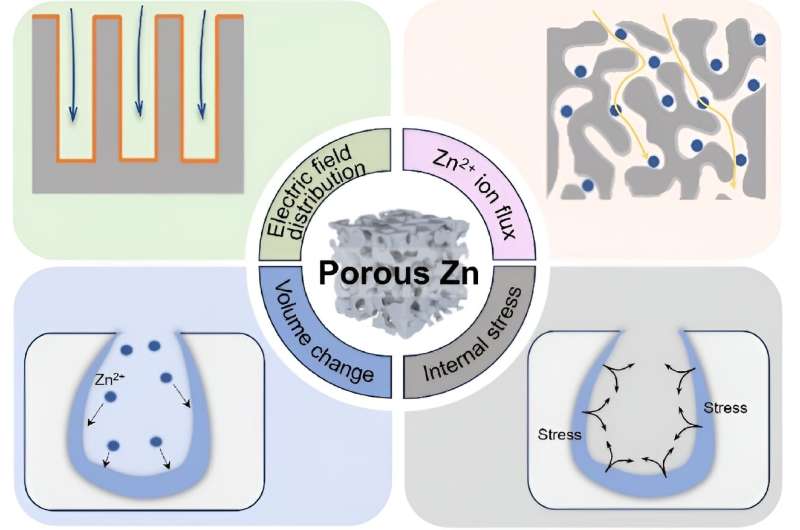
September 13, 2024 by Tsinghua University Press
Collected at: https://techxplore.com/news/2024-09-harnessing-power-porosity-advancing-aqueous.html
As the global demand for energy storage solutions grows, the limitations of current lithium-ion batteries, such as safety concerns and high costs, have driven the exploration of alternative technologies. Aqueous zinc-ion batteries (AZIBs) have emerged as a promising candidate due to their inherent safety, cost-effectiveness, and environmental sustainability. However, challenges like zinc dendrite growth continue to hinder their widespread adoption. Due to these challenges, there is a pressing need to delve deeper into innovative solutions to improve AZIB performance.
The study, conducted by researchers from Tsinghua University and the University of Technology Sydney, was published in Energy Materials and Devices. It provides a comprehensive review of recent advancements in the engineering of porous zinc metal anodes for AZIBs.
The focus of the research is on the structural orderliness of these porous anodes and their critical role in enhancing battery performance. The review underscores the potential of porous zinc anodes in overcoming the limitations of traditional planar zinc anodes.
The research highlights the significant advantages of porous zinc anodes over traditional planar zinc anodes. The porous structures provide numerous nucleation sites, which reduce the nuclear energy barriers and mitigate localized charge accumulation. This, in turn, suppresses dendrite growth, ensuring a longer battery lifespan.
The study also emphasizes the role of three-dimensional porous structures in facilitating uniform electric field distribution and homogeneous ion flux, which are crucial for stable zinc deposition and stripping.
Additionally, the substantial internal volume in these anodes accommodates volume changes and deposition stress, further enhancing battery performance. The review presents various fabrication techniques for porous zinc anodes, including etching, self-assembly, laser lithography, electrochemical methods, and 3D printing. The researchers also provide strategic insights into the design of porous zinc anodes to facilitate the practical implementation of AZIBs for grid-scale energy storage applications.
Prof. Dong Zhou, one of the senior researchers, remarked, “The development of porous zinc anodes represents a significant step forward in the advancement of zinc-ion batteries. By addressing the dendrite growth issue, we are moving closer to making AZIBs a commercially viable alternative to lithium-ion batteries. Our work not only provides a comprehensive understanding of the current advancements but also offers strategic insights into future research directions.”
The innovative design of porous zinc anodes has the potential to revolutionize the field of energy storage. By improving the performance and safety of AZIBs, these anodes could enable the development of large-scale, sustainable energy storage systems, crucial for integrating renewable energy sources into the grid.
Moreover, the advancements in porous zinc anodes could also lead to the development of safer and more cost-effective batteries for a wide range of applications, from electric vehicles to portable electronics, thus contributing to the global transition towards cleaner energy solutions.
More information: Yichen Ding et al, Porous zinc metal anodes for aqueous zinc-ion batteries: Advances and prospectives, Energy Materials and Devices (2024). DOI: 10.26599/EMD.2024.9370040

Leave a Reply